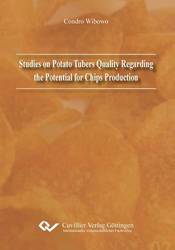| Fachbereiche | |
|---|---|
| Buchreihen (96) |
1377
|
| Nachhaltigkeit |
3
|
| Gesundheitswesen |
1
|
| Geisteswissenschaften |
2361
|
| Naturwissenschaften |
5403
|
| Mathematik | 229 |
| Informatik | 318 |
| Physik | 979 |
| Chemie | 1362 |
| Geowissenschaften | 131 |
| Humanmedizin | 243 |
| Zahn-, Mund- und Kieferheilkunde | 10 |
| Veterinärmedizin | 108 |
| Pharmazie | 147 |
| Biologie | 835 |
| Biochemie, Molekularbiologie, Gentechnologie | 121 |
| Biophysik | 25 |
| Ernährungs- und Haushaltswissenschaften | 45 |
| Land- und Agrarwissenschaften | 1004 |
| Forstwissenschaften | 201 |
| Gartenbauwissenschaft | 20 |
| Umweltforschung, Ökologie und Landespflege | 148 |
| Ingenieurwissenschaften |
1788
|
| Allgemein |
97
|
|
Leitlinien Unfallchirurgie
5. Auflage bestellen |
|
Erweiterte Suche
Studies on Potato Tubers Quality Regarding the Potential for Chips Production
Condro Wibowo (Autor)Vorschau
Leseprobe, PDF (92 KB)
Inhaltsverzeichnis, PDF (71 KB)
Potatoes (Solanum tuberosum L.), which are cultivated in many countries across the globe, belong to the essential food crops. In recent years, the production and consumption of potatoes has expanded markedly in developing countries. Nowadays, most of potatoes are consumed as processed products, mainly as French fries or chips. Chips, fried potato slices, are referred to as the “king of snack foods” in many countries.
Indonesia, the largest potato producer in Southeast Asia, imports frozen potatoes as raw material for processing purposes, whereas the inland potato production is dominated by tubers for table purposes. Accordingly, it is necessary to provide new cultivars for processing purposes in addition to already established sources. Tubers for chips production have to meet certain quality criteria to produce desired qualities, such as a light-yellow color, crispy texture and good flavor.
In addition to an appropriate cultivar, a sufficient and balanced supply of fertilizers should also be taken into account in order to produce tubers with desired properties. With regard to nutrients, potassium is absorbed in large amounts due to its essential role in plant physiology and ist subsequent influence on tubers yield and quality. The characteristic of tubers, as raw materials for processing purposes, is important for the quality of the final products.
One of the most important chips attributes that influence consumer preference is the color, which develops as a result from non-enzymatic browning reaction during frying. In order to produce chips with light-yellow color, cold-stored tubers require pretreatments to decrease the concentration of reducing sugars and sucrose. The most common procedure is the recondition of the tubers at a warmer temperature followed by a blanching process. However, this practice requires considerable amounts of energy, water and time. A pretreatment that can be applied directly to cold-stored tubers is necessary to shorten the preparation time for raw materials used for chips production. Ultrasonication, one of the advanced food technologies, is considered an alternative due to ist cavitation effects.
Responding to increasing demand for tubers for processing purposes in Indonesia, this study aims to examine the suitability of new Indonesian potato cultivars for chips production and to investigate the effect of potassium fertilization and ultrasonication treatment on the quality of potato tubers and produced chips.
In the present study, tubers and chips quality from three new cultivars, cvs. Tenggo, Krespo and Ping 06, were evaluated and compared to the established cultivars, cvs. Granola and Atlantik. Based on their processing properties, the new cultivars are appropriate for raw materials for chips production. Additionally, their chips properties meet the requirements of the Indonesian National Standard for the Production of Potato Chips.
In the second section of this study, potato tubers from four cultivars (cvs. Premiere, Secura, Jelly and Verdi) were obtained from five different locations during the cultivation in 2009 and 2010. Four types of potassium fertilizer (Sulphate of Potash, Patentkali®, Korn-Kali® and Muriate of Potash 60) were applied at different levels. The results indicate that the concentration of potassium, magnesium, manganese and zinc are higher in periderm than those found in parenchyma. The addition of potassium through fertilization contributes to increase potassium concentration in tubers parenchyma. Additionally, potassium fertilization and the location of cultivation influence the quality parameters of potato tubers.
In the third section, ultrasonication treatments at 35 kHz at 25 and 50°C were applied to potato slices from cvs. Nicola, Laura and Golden Wonder. A Confocal Scanning Laser Microscopy was used to visualize the changes of cells structure resulting from ultrasonication. The results show that ultrasonication treatments cause disruptions in the cell walls, decrease the sucrose concentration of potato slices and subsequently improve chips color.
| ISBN-13 (Printausgabe) | 9783954041824 |
| ISBN-13 (E-Book) | 9783736941823 |
| Buchendformat | A5 |
| Sprache | Englisch |
| Seitenanzahl | 110 |
| Umschlagkaschierung | matt |
| Auflage | 1 |
| Erscheinungsort | Göttingen |
| Promotionsort | Göttingen |
| Erscheinungsdatum | 17.08.2012 |
| Allgemeine Einordnung | Dissertation |
| Fachbereiche |
Land- und Agrarwissenschaften
|
| Schlagwörter | Potato tubers, quality, chips |








